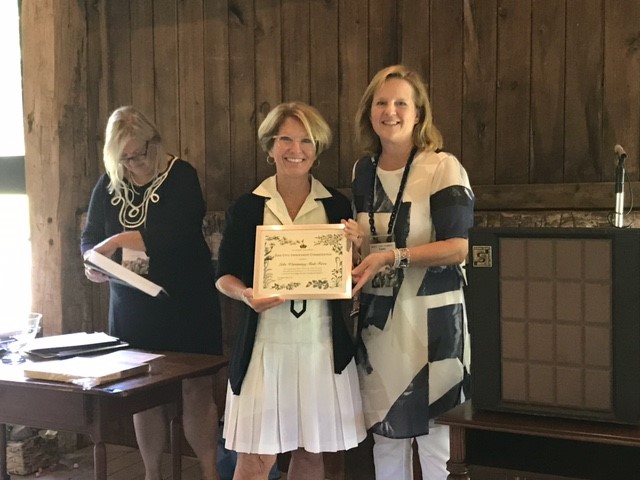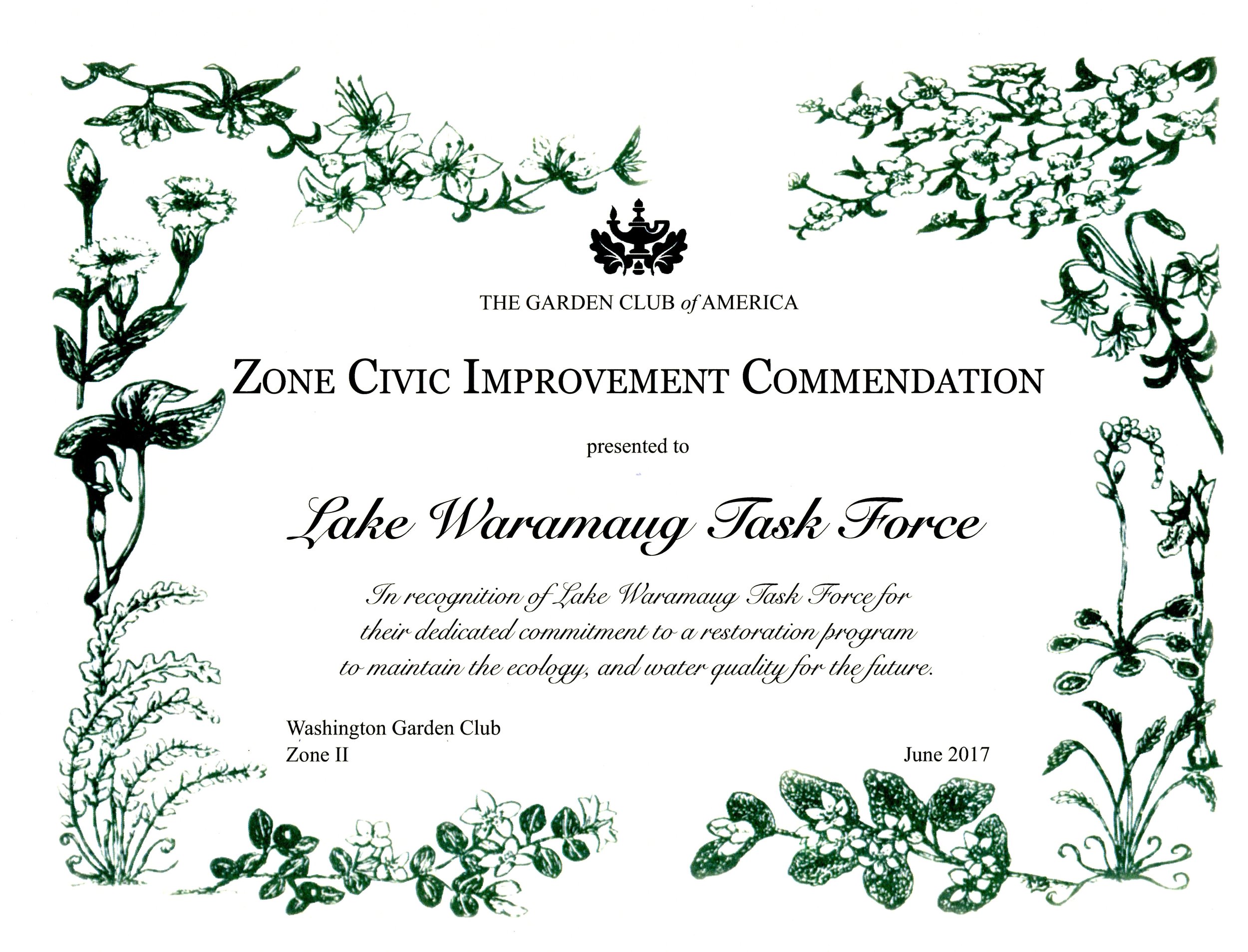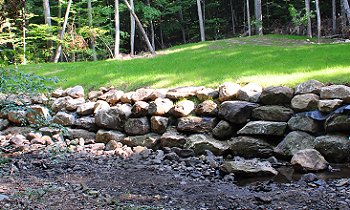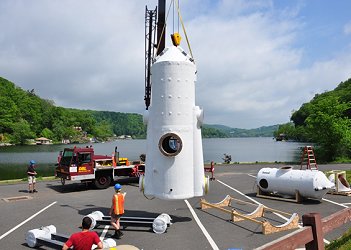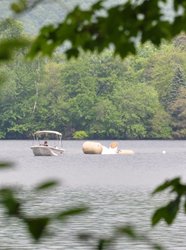The Lake Waramaug Task Force is a non-profit organization of volunteers and scientists that provides leadership in restoring and maintaining the ecology and water quality of Lake Waramaug and its watershed. Located in Litchfield County, Connecticut, Lake Waramaug is bordered by the towns of Washington, Warren and Kent. It is a Connecticut Heritage Lake.
'Tis the Season for Giving
Dear Friend of Lake Waramaug
We cannot keep Lake Waramaug clear, clean, and swimmable without you. The exclusive mission of the Lake Waramaug Task Force is to maintain the water quality of the Lake. 50 years ago, prior to the formation of the Task Force, Waramaug was effectively dead. Today, with the benefit of your steadfast support, the Lake is again alive and beautiful. But we must not let down our guard.
LWTF Fall 2017 Newsletter
Dear Friends of Lake Waramaug - Congratulations!
Your commitment to Lake Waramaug shows. This summer our beautiful Lake sparkled. Swimmers, boaters, water-skiers, kayakers, paddleboarders, campers, fisher-people... all enjoyed the benefits of your ongoing support: Waramaug’s clean, clear, swimmable water.
For the Lake Waramaug Task Force this was not only a beautiful summer, it was also a busy summer.
We welcomed Sean Hayden aboard as our new Executive Director. Sean was out on the Lake almost every day coordinating water quality testing, surveying for invasive weeds, making sure our in-lake aeration system kept working, overseeing the feeding and release of Zooplankton from our incubators tanks on Arrow Point, inspecting stormwater culverts and construction activities along the shoreline, consulting with our lake scientists and assisting landowners on lake-friendly ways to landscape within the Lake Waramaug watershed. Phew!
Call to Action - Five Key Challenges
The Lake Waramaug Task Force has been around for 40+ years. It is a non-profit scientific and educational organization dedicated to restoring and maintaining the ecology and water quality of Lake Waramaug and its watershed. The Task Force spearheaded the turnaround of the Lake beginning in 1975, and has been on the job ever since. Our Lake is clean, and the water quality is vastly better today because of the Task Force’s vigilance. But the job is not done. We must address each of the following five challenges if we hope to continue to keep the Lake clean and healthy. Read more here.
An example of the important work effected by LWTF are the erosion repairs at Sucker Brook, a stream responsible for an estimated 50% of the Lake's water inflow. Over the years, several sites have developed where the stream curves that have washed away much of the soil bank, undermining trees (and, in one location, State Route 45) and depositing tons of silt into the Lake. Read about the LWTF repair project here.
Task Force Welcomes New Executive Director
The Board of Lake Waramaug Task Force is thrilled to welcome Sean Hayden as the new LWTF Executive Director. Sean comes to the Task Force with over 30 years of experience in Environmental Conservation, and in depth knowledge of the ecology and history of Lake Waramaug. Prior to joining the Task Force, Sean spent 18 years as Executive Director and Soil Scientist at the Northwest Conservation District (NCD). During his tenure at NCD Sean worked side by side with the 34 towns and residents of Northwest CT – including the Task Force – to conserve natural resources by using sustainable development strategies.
Because the health of Lake Waramaug depends upon what flows into the Lake, Sean’s qualifications are exactly in line with the LWTF’s needs. He is an expert in Low Impact Development (LID), and a certified Soil Scientist, Army Corps of Engineers Wetland Delineator and Professional in Erosion and Sediment Control. He has worked with multiple wetlands and zoning commissions to revise municipal regulations, watershed planning, sediment and erosion control and storm-water quality management plans. In fact, many of you may already have met Sean. He is well versed on the issues facing Lake Waramaug and has been working with the LWTF on our complimentary Water Quality Protection Service for the past year.
Prior to working at NCD, Sean spent 3 years as an Agro-Forester with the Peace Corps in Kenya. One interesting tidbit: Sean is fluent in Swahili! And, he is “home grown.” Sean graduated from the University of Connecticut with a BS in Renewable Natural Resource Management & Engineering. He and his wife, Rose Guimaraes, live in Torrington and are avid “outdoors-people.” Sean can be reached at seanhayden@lakewaramaug.org
A Message from Tom McGowan
After many years of “only in your dreams” work with the Task Force I am retiring. I would like to express my deepest appreciation for everyone who has contributed time, funds and moral support for the mission of the Task Force over the past 43 years. The current and all past members of the Board, the First Selectmen of the three towns on the Lake Waramaug Interlocal Commission, Lake Waramaug Association and Lake Authority. Maintaining good working relationships with these organizations, the town land use boards and local land trusts has been and will continue to be crucial to the success of the Task Force.
Special thanks to our outstanding team of lake science advisors - our long time highly decorated lake research and development guru Dr. Robert Kortmann and his staff at Ecosystems Consulting Services, our invasive plant specialist Dr. George Knoecklein and our plant removal diving team under Matt Vogt. Also to the clerical and bookkeeping staff, especially Lois Pinney, and Hank Vallely who, with his assistance, have since 1999 carefully inspected all motor boats entering the lake for invasive plants.
Waramaug continues to enjoy improving water quality solely due to all the lake saving work we have done every year for so long. This work must continue and it must remain as it has been - ahead of the curve. All the very best to everyone. And here’s to the continued health and wellbeing of Lake Waramaug.
Task Force Gets Garden Club of America Award
The Lake Waramaug Task Force has been honored by The Garden Club of America! We received the GCA’s award for “The Lake Waramaug Task Force’s dedicated commitment to a restoration program to maintain the ecology and water quality for the future.” LWTF Chair Molly Butler Hart accepted the award from Karen Marche, GCA Conservation Committee, Zone II Representative at a luncheon at Hollister House. Kudos to all those who have supported the Task Force over the years. This prestigious award is yours as well as ours.
LWTF Spring 2017 Newsletter
Welcome to another season at Lake Waramaug. It was a busy winter for members of the Lake Waramaug Task Force…and we are looking at an equally busy and critical summer ahead.
First, and foremost, we bid a reluctant adieu to our long-serving and “storied” Executive Director Tom McGowan, whom many of you know as a dedicated champion of and spokesman for the Lake. Tom has retired from “active duty,” but promises to continue to be an advocate for the Lake whenever and wherever he can. Tom was integral to the formation of the Lake Waramaug Task Force in 1975 and has been its Executive Director since 1982. We are sorry to see him go, but understand his desire to “sit back and smell the roses.”
LWTF Winter 2017 Brief
The Task Force continues to move ahead to control the many soil erosion sites on Sucker Brook and other smaller streams that are harming the lake’s ecology. Storm water conveyed soil deposits from these erosion sites are creating deltas at stream and culvert inlets. These deltas rob the lake depths of the vital cold, well oxygenated water Lake Waramaug needs to stay healthy. They also create ideal habitats for invasive aquatic plants.
On Potash Brook, which runs to the lake from above the Hopkins Vineyard, we have permits in place to stabilize a stream bank erosion site and clean out eroded soil from an in-stream collection basin. Another soil full sediment basin on Hawes Brook in Warren is also permitted to be cleaned out in 2017.
Zoo-P Farm Up and Running
The Lake Waramaug Task Force's cutting-edge project to cultivate Zooplankton in the former aeration facility on Arrow Point is now operational. Modifications to the basins have been made and the microscopic organisms have been introduced. The initiative has been funded in part by start-up grants from the Ellen Knowles Harcourt Foundation (see below) and the Marion Wm. and Alice Edwards Fund, a fund of the Community Foundation of Northwest Connecticut. Additional funding was obtained through participation in the Give Local campaign in May.
Zooplankton are microscopic-sized aquatic animals that have been shown to be important in controlling algae populations in lakes. Although natural to Lake Waramaug, the zooplankton population was significantly diminished by the introduction of the alewife, a non-native fish, to the waters in the 1960s. The alewife feeds on zooplankton, and the upsetting of the natural ecological balance resulted in larger and more frequent algae blooms in the 1980s.
LWTF's chief limnologist Dr. Robert Kortmann pouring a seed batch of zooplankton into the newly modified "Zoo-P Farm" facility on Arrow Point.
(Photo by Dan Sherr)
Dam Evaluation Begins
Lake Waramaug's currentdrought-reduced water level had one positive effect: allowing engineers to begin survey work on the dam at the New Preston end of the lake which releases water into the East Aspectuck River. Necessary repairs and imporovements to the dam have been in disucssion for some time. It is estimated that all permits, drawings and specifications will be completed this fall so that bidding on the acutal construction can be done. That work is expected to begin in the spring or summer of 2017.
The Lake Waramaug Dam, owned by the Town of Washington, uses a pipe and gate system to control water flow and the lake's water level. Its aging technology has made it difficult to execute those adjustments. Although Connecticut keeps records of over 4,000 dams statewide, responsibility for inspection and repair has been shifted to the owners, as detailed in a new Dam Safety Regulation that took effect in February.
Although safety issues such as flood control, fire protection and safe boating are the primary considerations for dam maintenance, management of the water level is also a vital tool for water quality control. Low levels create a favorable condition for the growth of invasive weeds and cyanobacteria (blue-green algae), prevent the emigration from the lake of the harmful alewife population and inhibit the natural surface skimming of dead and dying organic material. Consequently, the Task Force has been active in encouraging the dam improvement project.
The Town of Washington has budgeted $50,000 for the engineering phase of the project and another $50,000 for construction.
Note: An interesting history of the Lake Waramaug Dam appears in the Lake Waramaug Association's May 2016 newsletter. "Waramaug's Unique Outlet - An Historical Perspective on Our Dam."
Survey Reveals Curly-Leaf Resurgence
Above: 2016 Survey Map: Red dots show Curly-leaf Pondweed sites.
Blue line is the survey track.
The Lake Waramaug Task Force's annual shoreline survey to evaluate the presence of invasive plants has revealed an alarming increase in the number, size and density of sites with Curly-leaf Pondweed.
The survey, conducted in late May and early June by Northeast Aquatic Research, discovered 104 sites with the non-native plant, more than double the number from the 2015 study. Of these, 32 contained only a single plant and 17 had five or fewer. However, 19 contained moderate plant growth defined as patches up to 50 square feet in area, and 18 sites had severe infestation with dense mats of up to 9,000 square feet.
Curly-leaf Pondweed (Potamogeton crispus) is an aquatic plant native to Eurasia that is considered an invasive in North America. It can spread rapidly; replacing native vegetation, clogging waterways and limiting recreational use. Ten years ago, CLP was the first invasive plant to be discovered in Lake Waramaug.
During this decade, the Task Force has been combating CLP though the use of hand-pulling by divers whose efforts are aided by the use of suction-harvesting equipment. However, the LWTF's plant scientist has identified 7 sites where CLP has been especially resistant and he has concluded that "hand removal in these areas is not working," raising questions concerning the efficacy of using these techniques alone.
Consequently, the Task Force is beginning to study the feasibility of alternative methods that have had long term success in other lakes, including testing the limited and targeted application of chemicals on large, dense patches of CLP. In addition, LWTF is considering additional surveys to monitor the threat more closely.
Alternative methods of controlling CLP will be thoroughly studied and the lake community will be informed of these findings.
The 2016 shoreline survey did provide some positive news: no other invasive plants, such as water chestnut and water clover, were discovered.
Seaplane Landing Ordiance Passes
In a public meeting held on June 17, the town of Kent became the third of the three Lake Waramaug towns to vote in favor of an ordinance prohibiting the landing of seaplanes on the lake. Washington and Warren had approved the ordinance on May 19.
The ordinance provides for a $250 fine for any landing on or takeoff from the lake. It will take effect fifteen days after proper public notification according to Connecticut General Statutes. The first selectmen of the three towns are directed to inform the FAA and all appropriate pilots' associations of the ordinance.
The Lake Waramaug Task Force, along with other environmental organizations, strongly supported the ordinance due to the threat that seaplanes could introduce destructive invasive species into the lake waters. The ordinance includes the following clause addressing the environmental concern: "Cognizant of the unavoidable danger of contamination of the Lake by aircraft from other water bodies which would compromise the many year undertaking to preserve the quality of the water of Lake Waramaug from invasive species and other pollutants...." More information on the ordinance here.
LWTF Spring 2016 Development Statement
Development near Lake Waramaug and in its watershed has been in a mini boom over the past two years. New homes and new landscaping plans are dotting the shoreline and surrounding hills. New neighbors are invigorating our community and enjoying the Lake. Growth is good. But unless development plans incorporate up to date best practices for water quality protection such growth threatens to diminish the work the Lake Waramaug Task Force, and the community in general, has done over the past 40 years to keep the Lake healthy. Read more here.
Zooplankton Project Awarded
(Above) Robert Nicholas (left), president of the Harcourt Foundation, presents the grant check to LWTF Chair Molly Hart & Exec.Director Tom McGowan.
Harcourt Foundation Grant
A cutting-edge LWTF plan to stimulate the growth of Zooplankton in Lake Waramaug has been awarded a $7,500 grant by the Ellen Knowles Harcourt Foundation based in New Milford, CT. The experimental project, which could result in significant benefits to water quality and clarity for lakes everywhere, was brought to the Task Force by its chief limnologist, Dr. Robert Kortmann. The idea emerged from discussions that evolved after the Task Force's land-based Hypolymnetic Withdrawal System on Arrow Point was retired in May 2015 in favor of two new in-lake Layer Aeration systems. The old structure consisted of a large concrete basin with four chambers that aerated water before returning it to the lake. Dr. Kortmann determined that the facility provided a unique opportunity to experiment with the cultivation of zooplankton, tiny organisms that feed on algae and are therefore beneficial to water quality.
(Another LWTF initiative, the stocking of the lake with brown trout, also benefits zooplankton by reducing the population of their predator, alewives.)
The LWTF Executive Director Tom McGowan and board member Dan Scherr produced a grant application stressing the innovative nature of the plan and the potential for broader application if successful. The Harcourt Foundation responded quickly with the grant and its president, Bob Nicholas, delivered a check personally to the LWTF Board on January 25. The grant will offset the planning and initial development costs to modify the Arrow Point basin.
LWTF Takes on Sucker Brook Erosion
Left: At the mouth of Sucker Brook, geese gather on the expanding delta caused by soil erosion upstream. Right: Above: One of the LWTF's completed soil erosion prevention projects on Sucker Brook in Warren.
The Lake Waramaug Task Force has begun an ambitious and complex project to lessen the amount of silt that washes into the lake from several erosion sites along Sucker Brook.
Sucker Brook is a scenic stream that meanders through the Warren woods and farmlands and provides Lake Waramaug with an estimated 50% of its water inflow. Depending on weather conditions, it can be characterized as a trickle or a torrent. Over the years, several sites have developed where the stream curves that have washed away much of the soil bank, undermining trees (and, in one location, State Route 45) and depositing tons of silt into the lake.
The resulting delta that has been created in the lake has a damaging effect on water quality and aquatic life since it blocks the entry of cool water into the lake and disturbs the delicate thermal stratification that keeps harmful nutrients in the lower depths. The delta is also a safety concern for boaters. It continues to grow in size and is especially prominent during low-water periods such as we are experiencing now. Attempts to remove the silt have been deemed impractical until the upstream source of the problem is addressed.
The process involves taking huge boulders, most excavated locally, and positioning them over heavy polyethylene fabric to prevent the water flow from washing away soil. With the cooperation and help of land owners along the brook, the Task Force has identified the most critical of the erosion sites and has completed the shoring up of the first two sites. Work on additional sites will continue this fall.
LWTF Executes Frost Site Conversion
1. Two new Layer Aeration towers after delivery to the Washington Boat Launch.
2. LWTF Executive Director Tom McGowan (left) being briefed by limnologist Dr. Robert Kortmann in front of the larger of the two new Layer Aeration Systems.
3. The larger Layer Aeration System at the Washington boat launch being lifted into position for towing to Arrow Point.
4. One of the new systems arriving at its new home east of Arrow Point.
The LWTF Board of Directors viewed a presentation in December 2014 by its chief limnologist, Dr. Robert Kortmann, regarding the potential benefits of converting the land-based hypolimnetic withdrawal system on Arrow Point (also known as the "Frost Site") to an in-lake system similar to the Layer Aeration towers that currently operate in the New Preston basin of the lake. After much discussion and analysis of the costs and potential benefits, the Board voted to implement this conversion.
Two new Layer Aeration Systems were ordered and delivered on May 28, 2015. They have been hooked up to a new compressor pump and are now operational. The larger of the new Layer Aeration towers is submerged on the east side of Arrow Point and the smaller tower is located on the shallower west side of the point. Their positions are made evident by the bubbling of released air, similar to the systems at the New Preston end of the lake.
The previous Frost Site complex took water from the east side of Arrow Point and channeled it through a series of concrete baffles, removing nutrients and aerating the water before returning it on the west side of the point. The system was installed in the early 1980s and had an anticipated useful lifespan of 25 years. Although largely responsible for water quality improvements over that time, those benefits have levelled off and maintenance costs increased rapidly. In addition, Dr. Kortmann stated that the Task Force has shifted its emphasis to a more sophisticated water management strategy that requires timing and water-level adjustments beyond the capability of the Frost Site.
Proposals under consideration for the Frost Site's concrete structure include the construction of solar panels to power the entire system and/or the possibility of nurturing the growth of zooplankton for possible re-introduction to the water. Zooplankton eat algae and therefore have a positive effect on water clarity.
LWTF Spring 2015 Newsletter
They said it couldn’t be done. We said differently.
This year marks the 40th Anniversary of the Lake Waramaug Task Force. With your help and support, we did what many deemed “un-doable.” We restored Lake Waramaug to its rightful place as the most beautiful lake in New England.
But our work is not over. We must remain vigilant and be proactive.
Read more here.
LWTF Elects New Chair
Molly Butler Hart of Warren has been elected Chair of the Lake Waramaug Task Force, succeeding Linda Frank of Washington.
Under the leadership of Ms. Frank for the last five years, the Task Force has continued to improve the quality of Lake Waramaug. Water clarity is now 8 to 10 feet in depth. Phosphorous readings are 50% lower than they were 20 years ago. Harmful algae blooms are now less frequent, less intense and of shorter duration. The lake is relatively free of invasive plant species.
The Task Force continues to improve the lake. This spring it installed a new and extensive aeration system designed to aid water clarity. An erosion control program is currently being launched to reduce phosphorous leakage into the lake.
Molly Butler Hart, the new Chair, is the founding Executive Editor of Money-Media, which now operates as part of the Financial Times of London. She is also a board member of the Johns Island Community Service League.
Other Task Force board members are: Anthony Bedini, Randy Bernard, Carolyn Brau, Kristen Browne, Jay Combs, Hilary Hopkins Criollo, Kenneth Hecken, Jim Hicks, Joan Larned, David Lindley, Richard Loughney, Kirby Mullen, David Robinson, Dr. Eric Salk, Dan Scherr, Lee Vance and Thomas Yamin. Tom McGowan is the executive director.
LWTF Fall 2014 Newsletter
We really didn’t see this coming quite so soon!
In our last newsletter we explained certain blue green algae, present in Waramaug and most fresh water lakes, are now classified as bacteria and called cyanobacteria. When these “algae-bacteria” die off they release toxins. In very high concentrations this can pose a health threat if lake water is ingested.
Well this summer this happened big time for the city of Toledo, Ohio.
Toledo draws its water supply from Lake Erie. This August an algae bloom produced a large volume of cyanobacteria in the area of the Lake from which their water is drawn. As a result, the entire city of Toledo’s water supply was shut off for 3 days.
Read more here.




